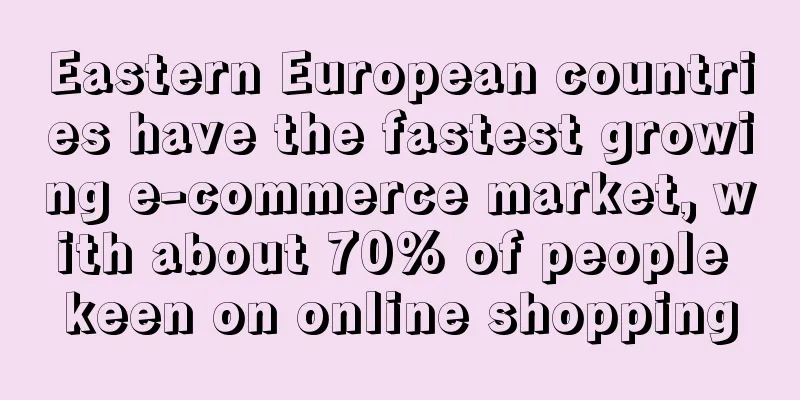Eastern European countries have the fastest growing e-commerce market, with about 70% of people keen on online shopping

|
Data from the 2020 European E-commerce Regional Report shows that the Western European market is still the most developed e-commerce market in Europe, accounting for 70% of the total European e-commerce, but the fastest growing e-commerce market is in Eastern Europe.
Data shows that the e-commerce markets in Bulgaria and Romania grew by an average of 30% in 2020, making them the fastest growing countries in Europe. Currently, the proportion of online shoppers in Romania is 31%, and in Bulgaria it is 29%.
According to statistics, Estonian online shoppers have the highest frequency of online shopping among Eastern European countries, with 76% of Internet users having shopped online at least once. In Latvia, the figure is 63%, while in Lithuania it is 64%.
According to LSM.LV statistics, 19% of Latvian Internet users have purchased goods once or twice within three months, and 12% of them have purchased five times. In the past three months, the categories with the highest sales on Latvian online platforms were clothing and footwear. Among them, 45% of Latvian netizens bought these products. Young people under the age of 25 are the main orderers of clothing and footwear. At the same time, data shows that Latvian residents tend to buy entertainment-related products online.
Another Eastern European e-commerce market country that cannot be ignored is Ukraine. With a population of more than 42 million, Ukraine has become the second fastest growing country in Europe in terms of e-commerce growth. As Ukraine's Internet penetration rate continues to increase (currently 44%), it will also become the leading country in the development of e-commerce in the Eastern European market.
At present, the Eastern European e-commerce market is dominated by international platforms such as AliExpress, Amazon and eBay, which are popular among local consumers. In addition, local online sales platforms in various countries also have a relatively loyal customer base. Relevant data shows that 53% of Internet users use domestic online platforms, such as Ukraine's largest e-commerce platform Rozetka.com.ua and Prom.ua.
Data from Ukrainian e-commerce platforms show that the most popular product categories have long been dominated by fashion and accessories, followed by electronic products and household products, as well as sports and entertainment supplies and personal care and beauty products.
According to the Euranet Plus 10 report, industry insiders said that online shopping is in the development stage in Eastern Europe, and more and more citizens and businesses will begin to try and adapt to this shopping model, and this trend is likely to continue.
Eastern Europe Cross-border e-commerce market |
Recommend
What is KuaiYiCloud? KuaiYiCloud Review, Features
KuaiYi Cloud optimizes warehousing and production ...
Awesome! Net profit exceeded 200 million in 3 months, and the market value of this big seller has exceeded 38.8 billion
Now that March is almost halfway through, while o...
PayPal updates its Seller Protection Program, requiring sellers to provide tracking numbers
Recently, PayPal in the United States has made po...
Americans start shopping, Amazon's Thanksgiving week sales break records
Amazon said Wednesday that it had broken sales re...
What is Khaos Control? Khaos Control Review, Features
Khaos Control is an ERP software solutions provid...
What is Bark&Co? Bark&Co Review, Features
Bark&Co was founded in 2011 and is a pet star...
Fast fashion faces sharp decline in next decade or less, UBS warns
Analysts say fast-fashion retailers could face re...
South Korea's sex ratio at birth drops to lowest level! Boys are no longer preferred
According to the "2020 Birth and Death Stati...
More than 50% of social media users shop online, and their favorite platforms are:
Recently, an organization conducted a survey on 1...
What is Spark Pay? Spark Pay Review, Features
Spark Pay is Spark's mobile payment product, p...
Alibaba International Station releases the top ten products of 2022
The list of best-selling domestic products contai...
What is Sinotrade International? Sinotrade International Review, Features
Zhongmao International (Shenzhen Zhongmao Internat...
Chinese fashion action figures and toys are accelerating their overseas sales during the Christmas season. Cainiao’s optimal warehouse helps Aofei Entertainment improve its cross-border logistics efficiency by 15%.
" My daughter loves Super Wings, so we bough...
There is a shortage of alcohol during the holidays in the UK, and price increases are inevitable!
As essential products for celebrating festivals ,...
Amazon has new rules for shipping, and sellers complain that it is "disastrous"...
Recently, Amazon UK released new rules regarding ...









